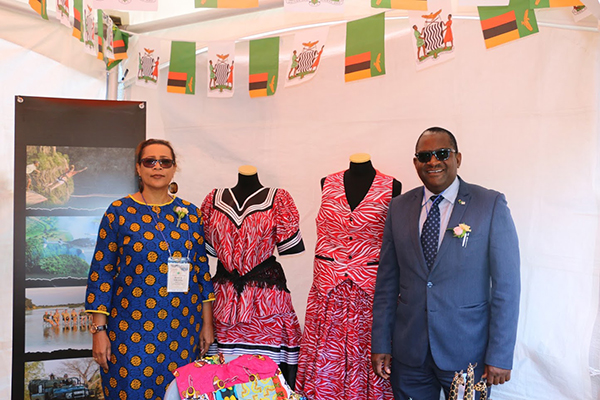Says Ambassador Simuusa of Zambia in Seoul
By Business Editor Lee Sam-sun with Reporters Kim Jung-mi and Sua Kim
Ambassador Wylbur Chisiya Simuusa of the Republic of Zambia in Seoul said, “We we are receiving and witnessing increased expressions of interest from Korean business people and tourists regarding Zambia, and recently a Korean business delegation undertook a trip to Zambia to explore various investment/business opportunities.”
Speaking at a recent interview with The Korea Post media, publisher of 3 English and 2 Korean news media for the past 33 years, Ambassador Simuusa added, “ I am confident that with on-going efforts, especially into the coming year, there will be more increased establishment of co-operation between Zambia and Korea which will result in increased trade and economic cooperation between the two countries.”
Zambia is a special country to Korea. In 2017 alone, more than 20,000 Koreans visited Zambia. Korean TV series such as Good Doctor, The Innocent Man and Dream High were aired on Zambian TV and drew a record number of viewers.
According to the Korean Ministry of Foreign Affairs, sister city partnerships have been established with Zambian cities by Gyeongsangnam-do Province and the city of Cheonan in Korea, further expanding mutual exchanges and cooperation, to include the New Community Movement, a medical facility program and a civil servant training program.
Zambia is known among Koreans as a country filled with rich natural resources, with over 200 kinds of minerals in its soil. About 30 of them are commercially valuable minerals, including gold (accounting for half of the country’s mineral production), platinum (the world’s second largest reserve after South Africa), chrome, asbestos, nickel and coal. Moreover, levels of education are higher on the average than those of neighboring countries (with an 86.5% literacy rate for the over-15 population), and English is used as a main language alongside Shona, the local language. The country also has a well-developed infrastructure of roads and power supplies and is in a strategic location, bridging southern and central Africa. Details of the interview follow:
Question: Please introduce in full the National Day of your country.
Answer: Every year on 24th October, Zambia celebrates its Independence Day in commemoration of the day it attained its freedom from British rule in 1964. Kenneth Kaunda became the country’s first President and he served from 1964 until 1991. Zambia’s independence came ten months after the collapse of the Federation of Rhodesia and Nyasaland, with Northern Rhodesia becoming the Republic of Zambia.
Many post-colonial African nations suffered from years of turmoil and war, however, for the most part, Zambia has managed to avoid this fate thus earning itself a reputation for political stability and a beacon of peace on the African continent.
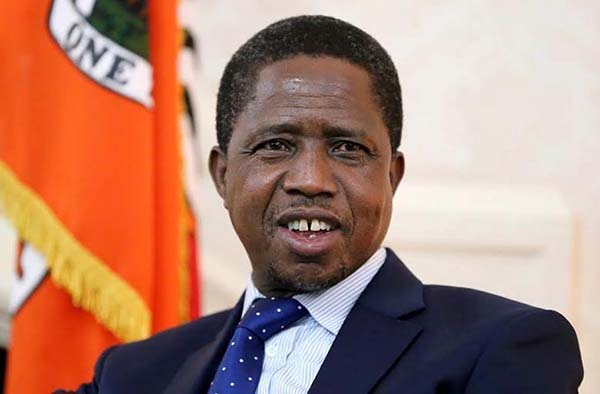
Q: Please introduce your Head of Government in detail.
A: H.E Edgar Chagwa Lungu (born 11th November 1956) has been the 6th Republican President of Zambia since January 2015. H.E. Edgar Chagwa Lungu was sworn in as President of the Republic of Zambia on 25th January 2015 at the National Heroes Stadium in the capital Lusaka. Under 5th Republican President H.E. Michael Chilufya Sata, H.E. Edgar Chagwa Lungu served as Minister of Justice and Minister of Defense. Following H.E. Michael Chilufya Sata's death in October 2014, H.E. Edgar Chagwa Lungu was adopted as the candidate of the Patriotic Front (PF), for the January 2015 presidential by-election.
After the PF won the 2011 election, H.E Edgar Chagwa Lungu became Deputy Minister in the Vice President's office. He was subsequently promoted to Minister of Home Affairs on 9th July 2012. He became Minister of Defense on 24th December 2013, and he functioned as Acting President during President Michael Chilufya Sata's tenure in office in 2013 to 2014. He has also held a string of central positions in his party, including Chair of the PF Central Committee on Discipline, and he became PF Secretary General and Minister of Justice on 28th August 2014. These positions were in addition to the Defense portfolio. H.E. Edgar Chagwa Lungu is married to Mrs. Esther Lungu and has six (6) children.
One of the major achievements of President Lungu and the PF Party has been infrastructure development. By building infrastructure, Zambian citizens now have better access to services and facilities. Under the road sector, the Government has been implementing the LinkZambia 8000 programme and other road projects aimed at transforming Zambia into a land-linked country. Apart from creating jobs, the road projects have been instrumental in contributing to the opening up of new business opportunities in the country. In the health and education sectors, there has been unprecedented infrastructure development with the commissioning of several hospitals, clinics, universities and schools.
Zambia has completed development of its next medium-term national development plan – the Seventh National Development Plan (7NDP). Anchored on the Zambia’s long-term development strategy, the Vision 2030, wherein Zambia aspires to become a prosperous middle income country by 2030, the 7th NDP will guide Zambia’s development strides between 2017 and 2021. The plan gives a direction of Zambia’s broad parameter of government development agenda in the next four years. The 7NDP seeks to move away from the sectoral approach to the integrated approach; it also seeks to abandon the silo approach that takes away policy harmonization and policy consistency.
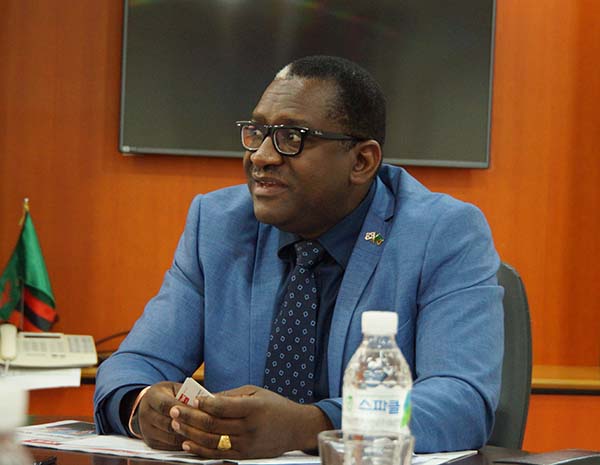
Q: Please introduce the progress of bilateral cooperation in the economic and other areas so far made during your tenure of office here and the outlook for further development.
A: I officially took up my post as Zambian Ambassador to the Republic of Korea on 31st October, 2017 (almost one year ago). The First thing I identified as I settled down was that given the huge potential existing in both South Korea and Zambia, there was an unacceptably low level of trade and economic co-operation between the two nations. I find this is because of the low levels of awareness in Korea about Africa in general and about Zambia in particular, also the same in Zambia about Korea.
As Zambia’s Ambassador to Korea I determined that one of the important areas to focus on is to raise awareness. As such, the main activity for me and the Embassy this year has been participating in cultural and tourism events, economic/business seminars and exhibitions, courtesy calls on key offices/organisations and visits to several companies. This strategy is working as we are receiving and witnessing increased expressions of interest from Korean Business people and tourists regarding Zambia. Recently a Korean business delegation undertook a trip to Zambia to explore various investment/business opportunities. I am confident that with on-going efforts, especially into the coming year, there will be more increased establishment of co-operation between Zambia and Korea which will result in increased trade between the two countries.
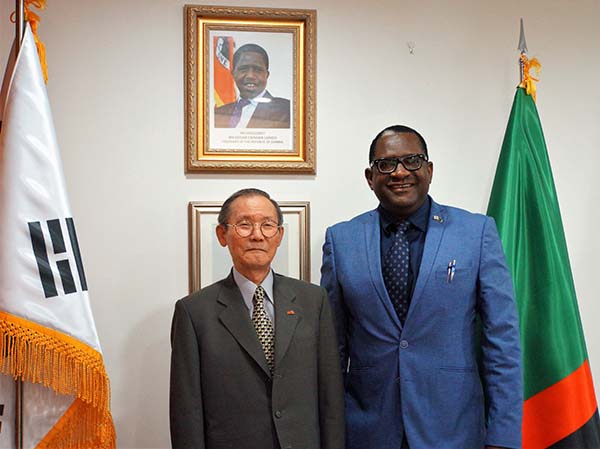
Q: Who are the Korean companies in your country actively contributing to the economic cooperation between the two countries?
A: Zambia and Korea established their diplomatic relations on 4th September 1990. From 1987 through 2015, Korea had granted $6.6 million of official development assistance to Zambia covering public health, aquaculture, capacity building and technical assistance.
Currently, Daewoo E&C was awarded the contract to construct the Kazungula Bridge Project. The construction of the Kazungula Bridge is a bilateral initiative between Botswana and Zambia, which commenced in December 2014 at a total cost of about US$234 million. The project scope includes the building of a bridge linking Botswana and Zambia over the Zambezi River to replace the existing ferry and includes one-stop border post facilities at Kazungula. Many economic spinoffs, such as reduced border transit time, improved procedures on trade facilitation, improved border management operations, and consequently, increased traffic and reduced time based transport and trade cost, are expected once the bridge is complete.
Samsung began its operations in Zambia in October 2010. Due to its positive performance, Zambia has become a regional hub effective as of April 2014. As a branch, Samsung Zambia oversees operations in Zambia, Zimbabwe, Mozambique, and Malawi. This alone indicates the significance of the Zambian market for the company.
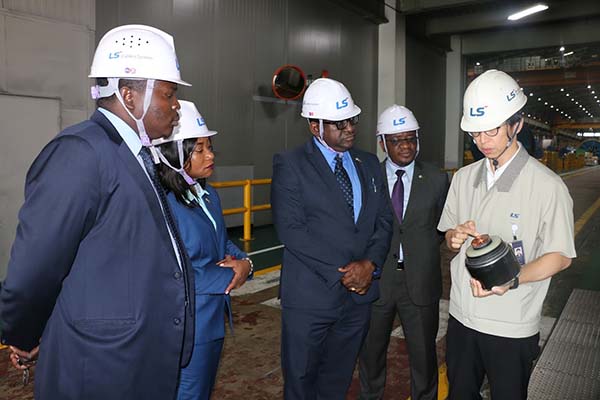
Q: What is the present volume of bilateral trade, its outlook in the next 12 months?
A: As of 2015, the trade volume between Zambia and Korea amounted to US$377,781. As indicated from the figures, Zambia is currently a marginal trade partner for Korea. The Zambian Embassy in Korea is working hard to ensure that the mismatch that exists between the two nations is corrected and to see the trade volume increasing.
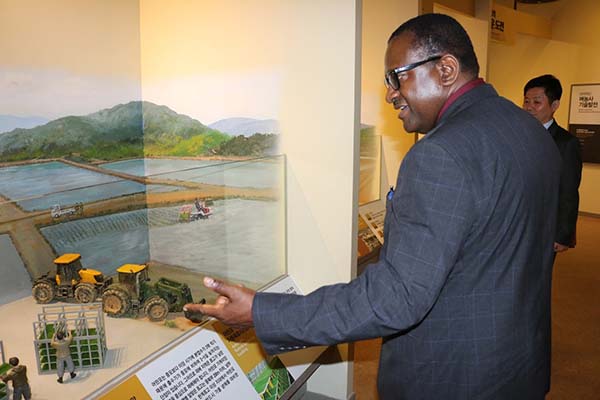
Q: What are the areas in your country where you might want Korean companies to invest and what are the areas where you wish your businessmen to invest in Korea?
A: Zambia is an attractive investment destination offering various lucrative investment opportunities in tourism, agriculture, manufacturing, energy and mining. The investment climate is characterized by a stable macroeconomic environment, stable political system, investment guarantees and security, duty free access to regional markets, wider Africa and USA markets and unrestricted repatriation of after-tax profits. Zambia has signed double taxation agreements with a number of European, North America, African and Asian countries. Hence investors from such countries are not liable to tax in more than one country or territory. The government offers a well-balanced package of fiscal incentives in priority areas as well as additional negotiated benefits to strategic investments.
Zambia has predictable laws and policies with a Government that is committed to investment. Government is pursuing a zero-tolerance policy against corruption. Local and foreign investors are treated equally. The people are highly peaceful and friendly. The Zambian economy is a well advancing free market economy without price, exchange and interest controls. There is reduced or free import duty on certain raw materials and imports of capital machinery/equipment.
Agriculture:
Zambia’s vast expanses of rich undeveloped land with free-flowing and easily accessible water provide extensive potential for agriculture production. This coupled with an ideal climate suitable for the production of exportable crops presents an opportunity for investment. It is estimated that only 15% of the arable land is under cultivation. Investors are invited to invest in the production of cut flowers, wheat, cotton, soybeans, tobacco and sugar; poultry; fisheries; leather and leather products; and agro-processing and ranching (livestock).
Tourism:
Attractive Investment opportunities exist in the hospitality (accommodation) sector in form of hotels, lodges, guesthouses and camps at all levels especially in the above tourism priority areas. Over7, 000 heritage and historical sites catalogued in the country remain unexploited and potential for tourism development. There are opportunities in tour operations and adventure activities in national parks. Investment opportunities also exist in establishing private game ranches. Water resources offer enormous investment opportunities for water related tourist activities such as white water rafting, canoeing and water skiing.
Mining:
Zambia is endowed with various mineral deposits. Copper, cobalt, lead and zinc are the most developed. Zambia has about 6% of the world’s known copper reserves. Other minerals found in Zambia include: gold, nickel, iron and uranium. There are also gemstones such as emeralds, aquamarine, garnets and amethyst. Given the variety of Zambia’s mineral resources, there are immense investment opportunities in the mining sector. These opportunities lie in exploration for new mineral deposits; gemstone cutting and polishing; establishment of new mines; and reclaiming copper from slag tailing dumps.
Manufacturing:
The manufacturing sector equally offers tremendous investment opportunities in agro-processing of tomatoes, cheese, fruits and other farm produce. Opportunities also exist in the creation of textiles and motor vehicles, motor cycles and bicycles assembly. Leather processing, wood processing, fish processing are yet other investment opportunities. Cement production also presents excellent investment given the regional deficit of the commodity.
Energy:
Zambia’s energy sector is endowed with enormous energy resources which include coal, hydro-electric power, woodlands and forests as well as other renewable energy forms such as solar and wind. Zambia has as estimated hydro- electric power capacity of 6,000MW, of which only about 1,948 MW has so far been installed. This represents only 32.5% of the total capacity. Hydroelectric plants account for 92% of the total installed capacity and 99% of the total electricity generated in the country. So far there are only two important inter-connectors to Zimbabwe and the Democratic Republic of Congo (DRC) which are the most important electricity export grids.
Zambia’s economy has been rapidly growing in the past 5 years and has experienced a power deficit. As such, investors are invited to invest in power generation projects. Opportunities for investment exist in electricity generation and transmission projects. In an effort to resolve the power deficit and ensure security and reliability of supply, Zambia is pursuing the development of transmission inter-connectors with neighbouring countries. One such project is the Zambia-Tanzania-Kenya power inter-connector. Other investment opportunities in electricity transmission include Zambia-Malawi inter-connector; Zambia-DRC inter-connector; Solwezi-Kolwezi inter-connector; and upgrading of large and small hydro projects.
Investment opportunities also exist in the exploration and production of petroleum resources; coal exploration and mining; and development of renewable energy sources which are supported by the National Energy Policy.
Q: Korean business leaders as well as the FTAs want rest and recuperation. What are the attractive tourist destinations of your country?
A: Zambia is one of Africa’s fastest-growing economies, a trend mirrored by the ever-increasing numbers of tourists flocking to this rich and diverse Southern African nation. Long celebrated for its peaceful history, rich and fertile land and the incredible natural wonders of Victoria Falls and the Zambezi River, it is perhaps the sheer wealth of activities now available to tourists that has seen Zambia rise up the tourist rankings in recent years.
Zambia in fact has a fairly long heritage and well-established reputation as one of Africa’s top safari destinations, and with such lush and sparsely-populated rural landscapes and so many different parks and safari activities to enjoy; it’s not hard to see why.
On top of this, Livingstone has come to be known as one of Africa’s action activities and extreme sports capitals. Zambia is also one of the safest countries in Africa making it easy to get out there and experience the country in all its glory, whilst the government has worked hard to make sure that none of the allure of the wild is lost along the way. And if all that activity gets a little too much, there are many leisurely options too.
Victoria Falls:
Victoria Falls presents a spectacular sight of awe-inspiring beauty and grandeur on the Zambezi River, forming the border between Zambia and Zimbabwe. It was described by the Kololo tribe living in the area in the 1800’s as ‘Mosi-oa-Tunya’ – ‘The Smoke that Thunders’. In more modern terms Victoria Falls is known as the greatest curtain of falling water in the world.
Columns of spray can be seen from miles away as, at the height of the rainy season, more than five hundred million cubic meters of water per minute plummet over the edge, over a width of nearly two kilometers, into a gorge over one hundred meters below.
One special vantage point is across the Knife-edge Bridge, where visitors can have the finest view of the Eastern Cataract and the Main Falls as well as the Boiling Pot, where the river turns and heads down the Batoka Gorge. Other vantage points include the Falls Bridge, Devils Pool and the Lookout Tree, both of which command panoramic views across the Main Falls.
As of December 2016, the KAZA visa for entry into both Zimbabwe and Zambia is available at all major ports of entry into both countries, making it easier than ever to experience both sides of the falls.
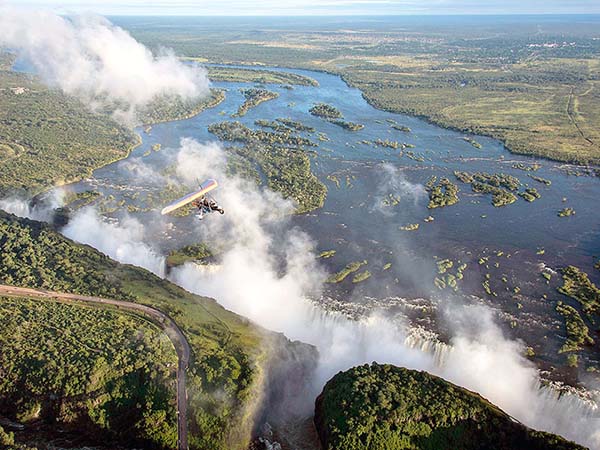
Adventure Activities:
Aside from its incredible National Parks and scenery, Zambia is fast becoming one of Africa’s most acclaimed adventure and extreme sports capitals. A range of action activities, mostly located in the Victoria Falls area, is drawing more and more visitors from all over the globe every year. Whether its bungee jumping from the Vic Falls Bridge spanning the deep Batoka Gorge with the Falls as a backdrop, river rafting down the wild Zambezi or having close and personal encounters with lion, cheetah or elephants, you are sure to find something to get the adrenaline pumping and make your trip to Zambia an even more unforgettable experience.
Zambia’s rainy season is from November to April. Most of the activities are available throughout the year except for the following that depends on the water levels and weather on that particular day:
Helicopter and Microlight flights over the Victoria Falls – depend on the weather
Livingstone Island (Devils Pool) – completely comes to a close between March to May when the water levels are high. However, this is entirely dependent on the season period.
Whitewater rafting – This depends on the high water rise which is usually March to May.
Bridge Activities ( Bugee, Abseiling, flying fox) – open throughout the year but closes when raining.
Under Spray – Only available in dry season from August to January depending on the water levels
Livingstone Museum – Open throughout the year except on Christmas and New Year’s days
The rest of the activities are available all year round.
Safari:
Zambia is a safari enthusiast’s dream with over 30% of the country’s land allocated to National Parks. Not only is there an array of some of the world’s biggest and best game parks to choose from for a Zambia tour or safari, such as the vast Kafue National Park or the famous South Luangwa, there are also many safari activities available too. Whether it’s a canoeing safari along the game-rich shores of the Lower Zambezi, or following in the footsteps of the pioneers into the Zambian interior on a mobile walking safari through North Luangwa National Park, you are sure to find something in the continent’s spectacular wildlife and scenery to thrill and amaze you.
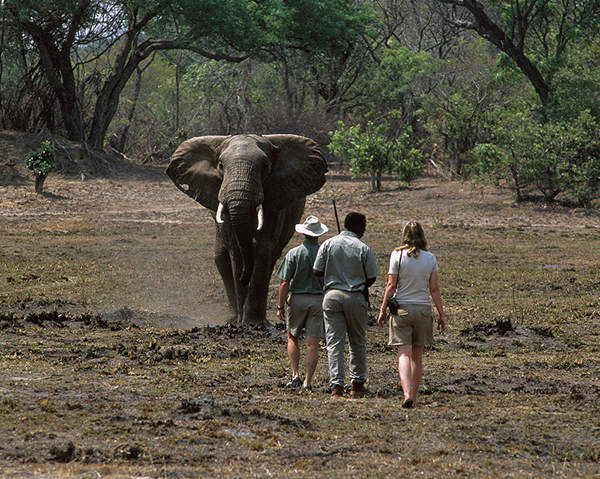
Leisure Activities:
Apart from the many adventure and adrenaline rush activities Zambia offers, there are many leisurely options as well. These include cruises on the upper Zambezi in multilevel cruise boats, stress relief and pampering at a spa, a day of golf or clay pigeon shooting, an insight into Zambia’s cultural heritage or even a trip to her hidden waterfalls.
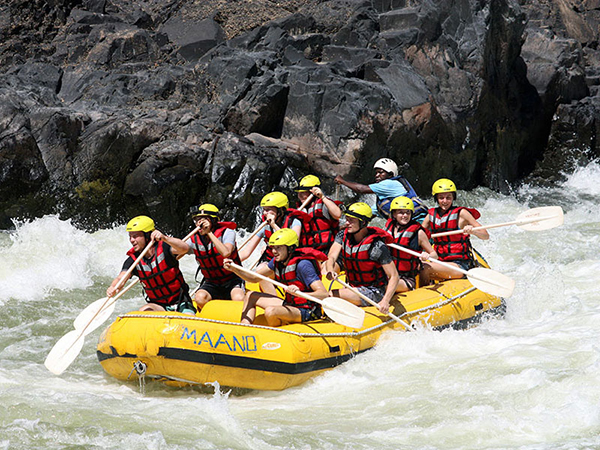
Q: Please add whatever other details that Your Excellency might consider to be important.
A: Travelling to Zambia from Korea is fairly easy with flights daily on Emirates (via Dubai), Ethiopian Airlines (via Addis Ababa) and South African Airways (via Johannesburg). Visas can be processed at the Zambian Embassy in Korea for US$50 for a single entry visa and US$80 for a double or multiple entry visas.
Korea has made an amazing transformation from aid-recipient country to donor country in a mere 50 years. It's worth emphasizing that this development success story has been underpinned by strong investments in science, technology and innovation. Korea's remarkable technological advancements, industrialization and understanding of development have allowed Korea to become a model which is very useful for Zambia and other countries to emulate.
